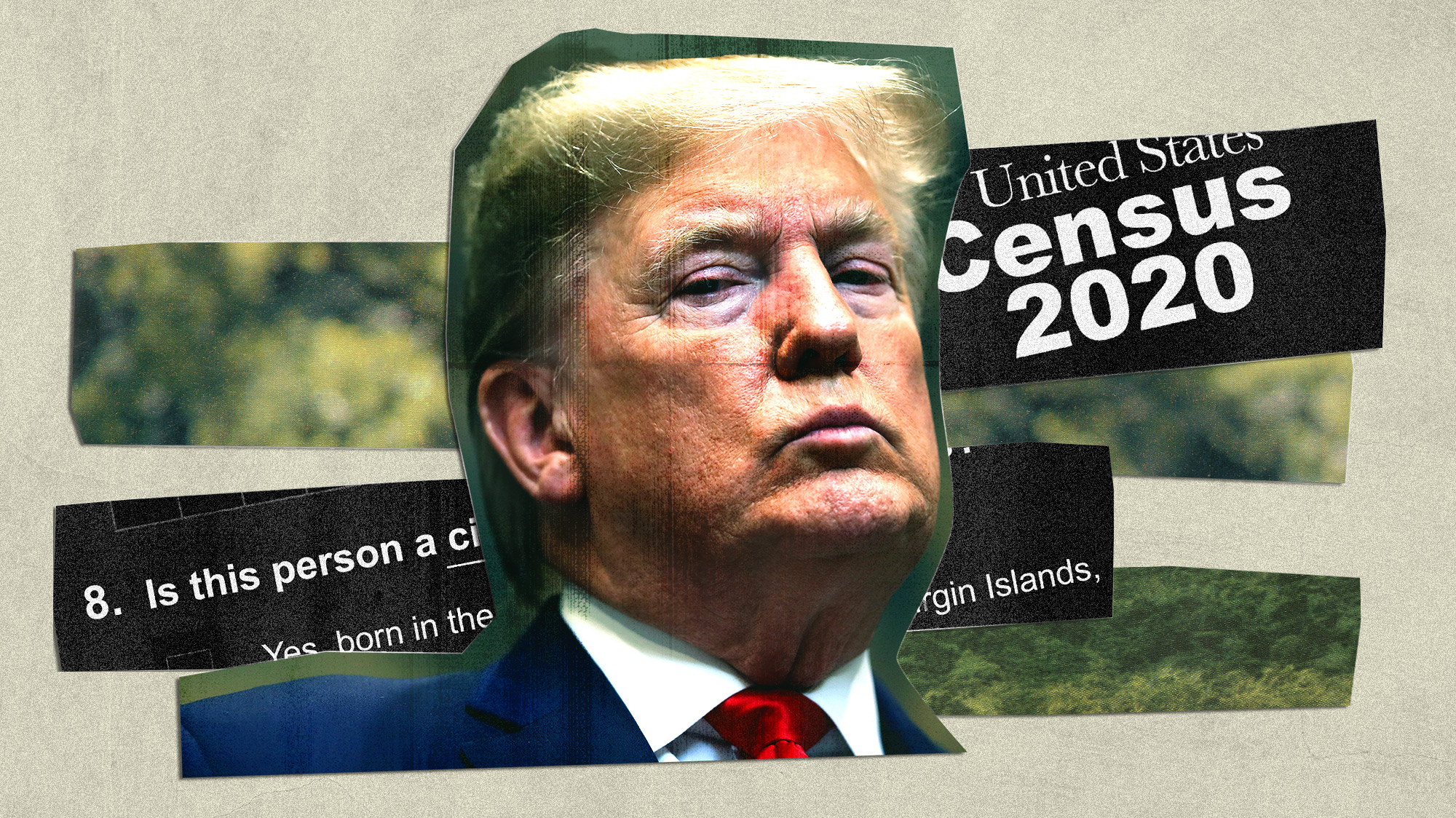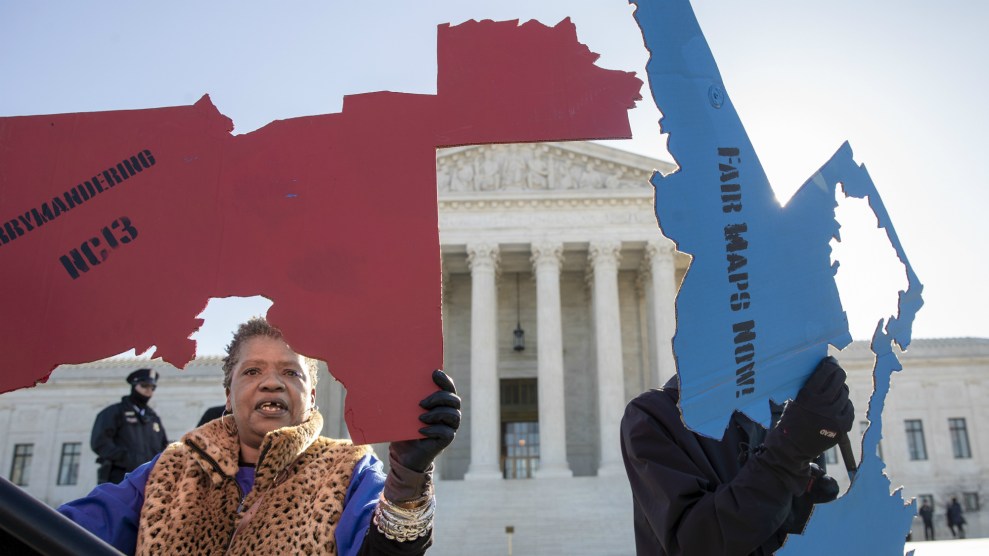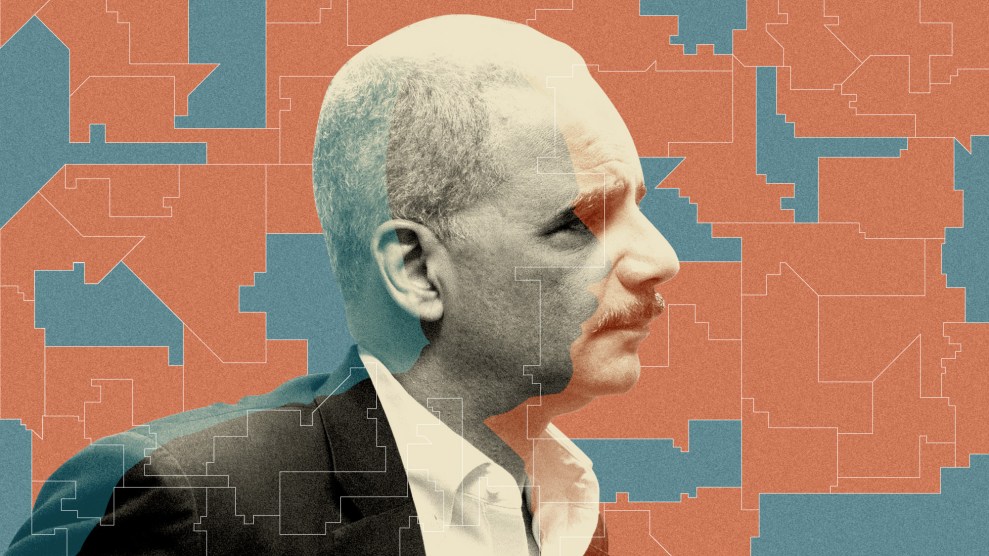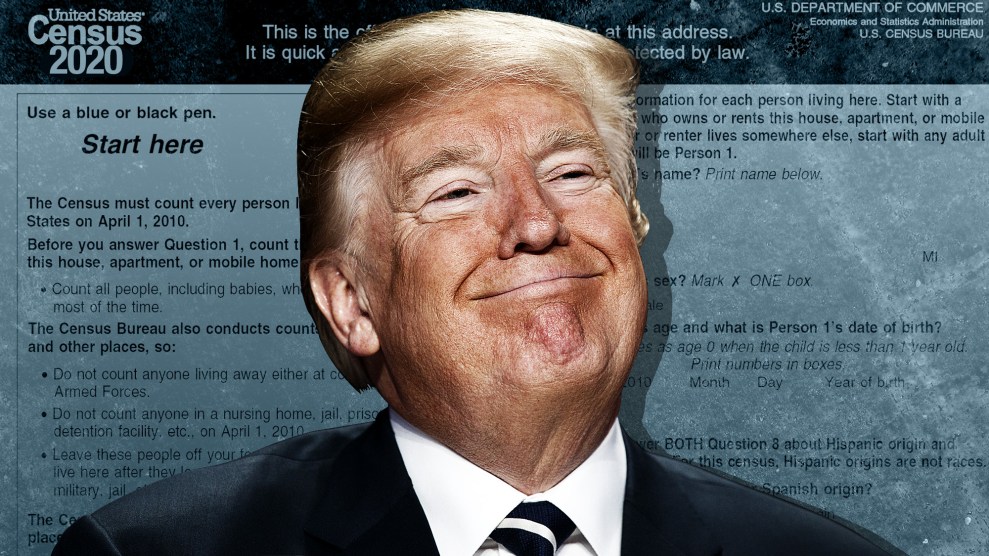Two days after Tropical Storm Imelda battered her district in Houston, state Sen. Carol Alvarado drove from its heavily Latino east side, past taquerias and signs for immigration attorneys, to another predominantly Latino neighborhood just north of the downtown skyline.
Senate District 6 is shaped like a dragon whose head starts in the city’s industrial outskirts while its body snakes and stretches into its center. She arrived at a red, Southwestern-style building that houses a community center named after Leonel Castillo, who led a boycott of the city’s segregated schools in 1970 and became the first Latino elected to citywide office. As she went to the podium to address more than 100 of her constituents, Alvarado praised Castillo as “a trailblazer who paved the way for so many of us, like myself, to be able to run for office.”
Listen to Ari Berman talk with President Barack Obama’s attorney general Eric Holder, about some of the most insidious voter suppression tactics across the country, in a wide-ranging conversation moderated by Broad City star Ilana Glazer, on this episode of the Mother Jones Podcast.
The daughter of a cement worker with a third grade education, Alvarado grew up in Manchester, a Latino neighborhood squeezed between the train tracks, the freeway, and the port of Houston. Rail cars frequently blocked the main road leading into the area. Her school playground overlooked massive chemical tanks and oil refineries that billowed gray smoke. Residents of the neighborhood breathe some of the dirtiest air in Texas and suffer from some of its highest cancer rates. Her 92-year-old mother still lives there, next to the Catholic church that Alvarado attends on Sundays. She got involved in politics “because of where I lived,” the 52-year-old Democrat told me over beef enchiladas at the community center. “I saw what was going on around me. It pissed me off.”
She joined the City Council, then the state House of Representatives, where she served five terms, and was elected to the state Senate in a special election in December 2018. Despite being outnumbered by Republicans in Austin, she’s proved to be a skilled legislator, helping pass 32 bills in the 2019 legislative session, and securing more funding for schools, flood protection, and mammograms. “You’re getting a very good return on investment from me,” she said jokingly at the meeting.
Even in the best of times, serving this district is a big job. Alvarado represents over 850,000 people—about 100,000 more than a typical member of Congress. After highlighting her legislative successes, Alvarado talked about the bills that would have been vital for her district if her Republican colleagues had not blocked them: One in five residents of Harris County are uninsured, but the legislature refused to expand Medicaid; Texas has some of the lowest voter turnout rates in the country, but it won’t adopt online voter registration; despite the recent mass shootings in El Paso and Santa Fe, Alvarado couldn’t pass a single one of her gun control bills.
These hot-button issues were a mere prelude to the fight to come. “The next session, as we move forward, the redistricting process will dominate,” she said, referring to the once-in-a-decade exercise of redrawing the state’s legislative boundaries that will follow the 2020 census. “The census gives us the numbers, we take those numbers, and then we use that during the redistricting process.” But if President Donald Trump’s GOP has its way, 2021 could be the year Texas and other Republican-controlled states upend the traditional way of counting who gets represented by state legislators. This could radically transform districts like hers, undoing decades of demographic change and disempowering lawmakers of color like Alvarado. And it would be a dramatic win for the conservative war on voting rights, allowing Republicans to game the system by consolidating electoral power they can’t win at the ballot box.

On July 11, a visibly agitated Donald Trump appeared in the White House Rose Garden to announce that his administration was dropping its bid to add a citizenship question to the 2020 census. The Supreme Court had blocked the plan two weeks earlier, with Chief Justice John Roberts writing that the administration’s claim that the question was needed to better enforce the Voting Rights Act “seems to have been contrived.” Civil rights groups said such a question would spark fear that the information would lead to deportations, causing a severe undercount of immigrant communities. Census Bureau researchers predicted it could lead to 9 million people not filling out the census. But, Trump said defiantly, “I’m here to say we are not backing down on our effort to determine the citizenship status of the United States population.”
Trump then made a move that could still turn citizenship data into a political tool to boost the influence of white Republican areas. He announced an executive order calling on federal agencies to send all existing information on who is and isn’t a citizen to the Department of Commerce, which oversees the Census Bureau. Trump suggested how those details might be used: “Some states may want to draw state and local legislative districts based upon the voter-eligible population.” For the past decade, Republicans have sought to exclude noncitizens from the redistricting process. Now Trump was going even further, suggesting that anyone who is not eligible to vote, including children, did not have to be counted toward apportioning representation at the state and local level.
It’s long been a bedrock principle of American democracy that elected officials represent all of their constituents, whether or not they are eligible to vote. Almost all congressional and state legislative districts are drawn based on their total populations, including voters and nonvoters, citizens and noncitizens, adults and kids. Yet while the 14th Amendment requires that congressional districts are based on total population, the Supreme Court has never definitively ruled on what the standard should be for state districts, although since the 1960s nearly all states have counted everyone. Drawing state legislative districts based on eligible voters instead of total population would be a huge win for Republicans, who tend to represent areas with fewer noncitizens. Democrats currently hold all of the 50 upper state House seats with the highest percentages of foreign-born noncitizen residents.
Using the voting-eligible population as the metric for reapportionment could lead to half of all state legislative districts in the country being redrawn. Those new districts would exclude up to 55 percent of Latinos, 45 percent of Asian Americans, and 30 percent of African Americans from being counted as constituents—compared to 21 percent of white people, according to the Leadership Conference on Civil and Human Rights. As the group argued in a legal filing in 2015, “This would amount to a massive shift in political power away from groups that are already disadvantaged in the political process and further concentrate power in the hands of a white plurality that does not adequately represent the full diversity of the total population.”
That seems to be the point. Thomas Hofeller, the late Republican gerrymandering mastermind who played a central role in the push for the citizenship question on the census, wrote in a 2015 study, commissioned by the conservative news site Washington Free Beacon, that redrawing districts based on the voting-age citizen population “would clearly be a disadvantage to the Democrats” and “advantageous to Republicans and Non-Hispanic Whites.” (The document came to light after Hofeller’s estranged daughter turned over his hard drives to Common Cause as part of a lawsuit challenging gerrymandered maps he’d drawn in North Carolina.) In Texas, such a shift would leave almost 2.7 million noncitizens and 7 million children without political representation, according to census data compiled by the state’s Hispanic legislative caucus.
No Senate district in the state would be affected more than Alvarado’s. More than half of her constituents cannot vote—30 percent are under 18, and 22 percent are adult noncitizens. Because the US Supreme Court has ruled that districts must be roughly equal in population, Alvarado’s district would have to be redrawn, potentially adding hundreds of thousands of new voters so she’d have the same number of voters as other districts with fewer children or noncitizens, causing her district to grow to more than 1 million people. The district might be “packed” or “cracked”: It could swell with more Democratic voters, weakening the party’s representation elsewhere, or it could take in thousands of Republican-leaning voters, diluting its Latino majority and possibly costing Alvarado her seat. “If I have to absorb hundreds of thousands of people, that’s going to change the dynamics of the district,” she told me. “And it changes all the adjoining districts.”
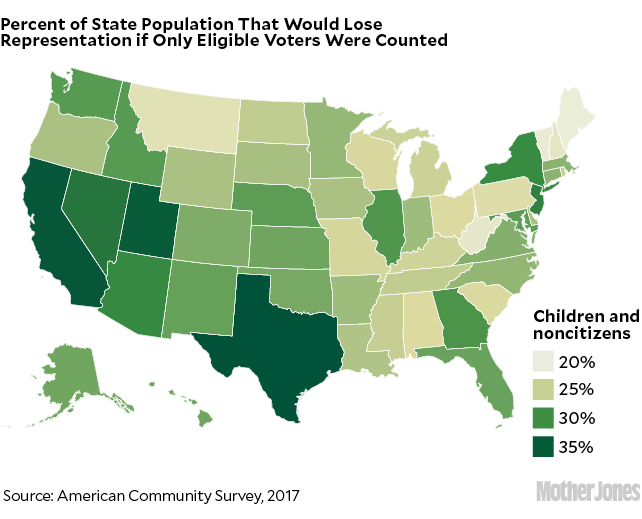
If Texas takes Trump up on his offer to use federal data to only count voters, it would have profound consequences. Democrats need only nine seats to regain control of the Texas House of Representatives for the first time since 2002, but redrawing districts based on eligible voters would keep the state solidly red, shifting eight or more seats back to the GOP, according to an analysis by Andrew Beveridge, a professor of sociology at Queens College in New York. In the past year, Texas has gained about nine Latino residents for every white resident, and only 34 percent of the state’s kids are white. These demographics should help Democrats when new maps are drawn in 2021. But excluding children and noncitizens from the count would radically reduce the impact of demographic change. Moreover, the year 2021 will be the first time in half a century that Texas and other states with a history of racial discrimination will not have to get their redistricting maps approved by the federal government under the Voting Rights Act. These changes, combined with a recent Supreme Court decision that federal courts cannot review partisan gerrymandering, could lead to an unprecedented effort by Republican-controlled states to weaken Democratic power and sideline communities of color.

“I represent everybody,” said Texas state Sen. Carol Alvarado. “People are people.”
Sandy Carson
Under this new system, heavily Latino districts in Houston, Dallas, and South and West Texas would likely be dismantled, with their electoral power redistributed to white strongholds. The Texas legislature would see its lowest level of Latino representation since the 1980s. And if this change were adopted nationwide, the number of Latino state legislators could decline by 12 percent, according to Carl Klarner, a political scientist and elections forecaster. “It would dramatically diminish Latino voting power,” says Thomas Saenz, president and general counsel of the Mexican American Legal Defense and Educational Fund, which has filed suit against the executive order. “It’s a power grab,” Beveridge said. “If they were able to do this, they would take the country back in time.”
At the center of the effort to redefine political representation is Edward Blum, the conservative activist who organized the successful challenge to the Voting Rights Act in 2013 and has been trying to overturn affirmative action at Harvard. Blum sued Texas in 2014 to force it to draw state Senate districts based on citizens or eligible voters. The Supreme Court shot him down, but it left an opening that Trump walked through with his executive order. Blum predicts that “many states, counties, cities, and other jurisdictions will explore using a population metric other than total population in the upcoming redistricting cycle.”
Blum told me that Republican officials and political consultants in Texas, Arizona, Florida, Tennessee, and Missouri have already called him. “I’m not involved in Republican electoral politics. However, my phone rings a lot from people who are,” Blum said. “This is being discussed. This is on everyone’s radar…So many attorneys general, so many heads of redistricting committees in state legislatures are aware of this.” In February 2019, Missouri Republicans introduced legislation to draw their state’s districts based on “one person, one vote,” widely assumed to mean something other than total population. Alabama has sued the Census Bureau to exclude undocumented immigrants from counting toward congressional apportionment.
Blum’s effort is backed by Hans von Spakovsky, a Heritage Foundation senior fellow and a former member of Trump’s disbanded election integrity commission, who has led the push for voter ID laws and other voting restrictions. Von Spakovsky has long perpetuated the myth of widespread voter fraud and played an instrumental role in purging longtime civil rights lawyers from the Justice Department’s Civil Rights Division while serving as a top lawyer there under George W. Bush. In August 2019, von Spakovsky spoke on a panel about redistricting in Austin at the annual meeting of the American Legislative Exchange Council, the conservative group that writes model legislation in conjunction with corporate interests. “All of you need to seriously consider using citizen population to do redistricting,” he told 200 Republican state legislators. He explained why: “The higher the number of noncitizens in a district, the greater the chances they’re going to vote for a liberal. The higher the number of citizens in a district, the higher the chances they’re going to vote for a conservative.” (Cleta Mitchell, a conservative lawyer who spoke alongside von Spakovsky, urged the lawmakers to destroy their notes from the conference so they couldn’t be cited in future lawsuits.)
This stealth campaign to redraw the political map has raised the already high stakes for the 2020 election, in which the Democratic Party is trying to win back state houses to reverse the GOP’s redistricting edge. And a Democratic president could try to stop the reapportionment scheme in its tracks by blocking the release of citizenship data. (Elizabeth Warren has pledged to do this if elected president, as did Cory Booker and Julián Castro when they were still candidates.)
Alvarado fumed when she thought of what might happen to her district if only eligible voters were counted. “I represent everybody,” she said. “Children can’t vote, but I represent them. I go to the Capitol during the session and a priority is education.” It was “a bunch of BS” that noncitizens also might not be counted as constituents. “People are people, whether they were born here or they migrate here. We welcome them. They are part of our community.” She said Democrats in the Texas legislature are on high alert. “We’ve been talking about it and we’re concerned about it. I’m sure it’s going to be debated heavily—what numbers do we look at when we’re drawing the maps? Is it the [citizen] population? Is it all people? And that’s why the 2020 election is going to be so important.”
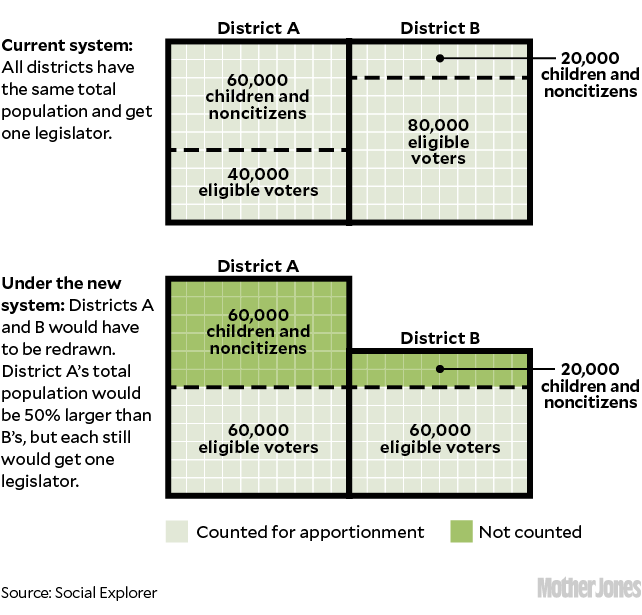
The fight over who gets counted is as old as the United States itself. Fair representation was one of the founding principles of the new republic. “No taxation without representation” was a core principle of the revolution, which was followed in Great Britain by a revolt against the “rotten boroughs” of the British Parliament, where absentee lords representing as few as a dozen people received more seats than growing industrial cities like Manchester and Birmingham. Even though most of the newly formed states denied the vote to women, black people, and propertyless white people, some founders believed everyone was entitled to political representation. “There can be no truer principle than this—that every individual of the community at large has an equal right to the protection of government,” Alexander Hamilton said at the Constitutional Convention.
Of course the democratic institutions the founders created often fell short of these ideals. Small states had more power than large ones in the Senate, and slave states had more power than free ones in the House because enslaved African Americans were counted as three-fifths of a person for purposes of representation. And both small states and slave states had disproportionate power in the Electoral College.
When the post–Civil War slate of constitutional amendments was being debated in 1865 and 1866, some radical Republicans, led by Rep. Thaddeus Stevens, proposed apportioning House seats based on “legal voters” instead of total population. They predicted—correctly—that newly emancipated African Americans would be disenfranchised yet still counted by former slave states seeking to grab even more power than they’d had under the three-fifths clause. But other pro-Reconstruction Republicans argued that, despite this prediction, nonvoters such as women and children were also entitled to representation even if they could not vote. “No one will deny that population is the true basis of representation; for women, children, and other nonvoting classes may have as vital an interest in the legislation of the country as those who actually deposit the ballot,” said former House speaker Rep. James Blaine of Maine.
In the end, the 14th Amendment stated that “Representatives shall be apportioned…counting the whole number of persons in each State.” That settled the issue at the federal level for a while, but in the 1920s, after the country’s population shifted from rural to urban areas following a wave of immigration, nativist politicians sought to exclude noncitizens from counting toward congressional apportionment. Rep. William Vaile of Colorado said he wanted to count a “more distinctly American population,” since at the time of the 14th Amendment, the number of immigrants “had not become sufficiently noticeable to be recognized as a danger or an evil.”
After the 1920 census showed that more Americans lived in urban areas than rural ones, Congress refused to reapportion its seats based on the new numbers for the first time in US history. Throughout the ’20s, rural legislators sought to pass a constitutional amendment excluding noncitizens from congressional apportionment, but liberals like Rep. Fiorello LaGuardia of New York argued persuasively that all inhabitants were entitled to equal representation. “The exclusion of aliens is only the first step in getting away from a popular and constitutional government of free men,” LaGuardia said on the House floor. “Perhaps this is only the entering wedge—first to exclude aliens from the count. And then the next step will be to exclude those who do not own property; and then the next step will be to exclude all those who do not own real property, until the government will be controlled entirely by a small privileged class, as it was in England at the time of the American Revolution.” Still, the House didn’t adopt a new congressional map that reflected the changing population until 1929.
Total population would remain the basis for allocating House seats, but state legislative officials had far more leeway. In the late 19th and early 20th centuries, conservative white legislators drew political districts with wildly unequal populations to give more influence to lawmakers from rural areas. This advantage was locked in by amending state constitutions or by simply ignoring the constitutional requirement to redraw legislative districts every 10 years to account for population change.
In the 1930s, “In the typical state, just 37 percent of the population elected a majority of seats in at least one chamber,” write political scientists Stephen Ansolabehere and James M. Snyder Jr. in The End of Inequality: One Person, One Vote and the Transformation of American Politics. A 1926 amendment to California’s constitution specified that no county could have more than one state Senator, which meant that by 1960 the 6 million people of Los Angeles County had the same number of senators—one—as a district with 14,000 residents spread across three counties east of the Sierras. The distribution of representation became so skewed that it was possible for just 10 percent of Californians to elect a majority of the state Senate. The stacked deck of yesterday makes the gerrymandering of today look tame.
The Supreme Court struck down this system of rural minority rule in a series of “one person, one vote” cases in the early 1960s, ruling that state legislative and congressional districts must be roughly equal in population and “apportioned on a population basis.” This shifted power from sparsely populated areas to the urban and suburban population centers where Americans increasingly lived. “The fundamental principle of representative government in this country is one of equal representation for equal numbers of people, without regard to race, sex, economic status, or place of residence within a State,” Chief Justice Earl Warren wrote for the majority in Reynolds v. Sims. As he pithily put it, “Legislators represent people, not trees or acres.” Of all his landmark rulings, Warren considered this transformation of democratic representation his most important achievement on the court.
That might have been the end of the issue if not for Edward Blum.
In 1997, Houston created four majority-minority City Council districts, two in heavily black areas and two in heavily Latino areas. The city had recently annexed a wealthy white planned community called Kingwood. The city connected Kingwood to a district in Clear Lake City, a similar planned community about 40 miles away, maintaining the surrounding majority-minority districts. Blum, a former stockbroker who lived in Houston and ran unsuccessfully for Congress in 1992, filed suit in federal court against the redistricting plan, alleging it was an illegal racial gerrymander. Yet he also noticed that predominantly nonwhite districts had greater numbers of noncitizens and fewer eligible voters than the adjoining predominantly white districts. He thought this gave voters in districts with more people of color a more powerful vote, since it took fewer eligible voters to elect a candidate there, which he said didn’t “represent the spirit of ‘one person, one vote.’” He argued that Houston should draw its City Council districts based on eligible voters rather than total population.
Blum lost in district court and on appeal. In 2001, the Supreme Court declined to hear the case, but Justice Clarence Thomas dissented, believing that Blum’s argument about population counts had merit. Thomas left the door cracked for Blum to come back to the high court.
Blum turned his attention to challenging the Voting Rights Act and affirmative action, but kept the population issue on the back burner. In 2014, he sued Texas to force it to draw its state Senate districts based on eligible voters. Blum recruited Sue Evenwel as his lead plaintiff, a tea party activist who lived in a red district with a small number of noncitizens. As the chair of the Titus County GOP, she claimed that the current system was designed to give “equal representation to a block of undocumented people who are not eligible or registered to vote.” Her co-plaintiff was a Christian fundamentalist who claimed the Earth is the center of the universe and that unicorns are real. They asserted that, by counting nonvoters to apportion seats, Texas was denying “eligible voters their fundamental right to an equal vote.”
The Supreme Court took the case, and in 2016 it unanimously ruled that Texas could not be forced to abandon total population if it didn’t want to. Justice Ruth Bader Ginsburg wrote a majority opinion joined by five justices, including Chief Justice Roberts, that strongly suggested states should count all constituents, not just voters, when drawing legislative districts. “As the Framers of the Constitution and the Fourteenth Amendment comprehended, representatives serve all residents, not just those eligible to vote,” Ginsburg wrote. “Nonvoters have an important stake in many policy debates and in receiving constituent services. By ensuring that each representative is subject to requests and suggestions from the same number of constituents, total-population apportionment promotes equitable and effective representation.”
However, Ginsburg stopped short of banning states from counting only eligible voters, which the Obama administration had advocated during oral arguments. In a concurring opinion, Thomas said the Constitution “leaves States significant leeway” to draw districts as they see fit. And Justice Samuel Alito wrote that the court might finally answer the “important and sensitive question” of the constitutionality of drawing districts based on eligible voters when a state drew a map to that effect.
That’s where Trump’s failed push to add a citizenship question, followed by his executive order on citizenship data, comes in. Currently, any state that wants to adopt a citizenship-based map that the Supreme Court might uphold faces a practical problem: States don’t have the street-level citizenship data necessary to draw districts that exclude noncitizens in their population counts. To get this information, the Census Bureau would have to collect citizenship data through the decennial census, which it hasn’t done since 1950. As Hofeller put it in his unpublished study, “Without a question on citizenship being included on the 2020 Decennial Census questionnaire, the use of citizen voting age population is functionally unworkable.” But with this data in hand, a state could test the limits of the Evenwel decision. “If the state of Texas decides it’s going to use citizen population for their state Senate or state House, they’re going to get sued, and we’re going to find out pretty quickly what the Supreme Court thinks about that,” Blum told me. He said his organization, the Project on Fair Representation, would provide legal counsel for any state facing such a lawsuit. He could soon go from suing Texas to supporting it.
One of the flaws—or perhaps it’s a feature—of this plan is that the citizenship data it depends on could be a mess. Even if states like Texas want the data that Trump has promised to release—the Census Bureau said in July that no state has requested it yet—it’s not clear that it will be reliable. During the fight over the citizenship question, the Census Bureau told the administration that using state and federal databases known as administrative records would be more accurate and less obtrusive than asking every person in America their citizenship status. But those records are hardly foolproof.
A leaked Census Bureau document estimates that the agency already has access to citizenship information for 90 percent of people in the country. But more marginalized and transient groups are less likely to show up in official databases, particularly recent immigrants and non-English speakers, as well as people who move a lot, work nontraditional jobs, or possess varying forms of documentation. Redistricting maps are drawn street by street, which means the Census Bureau will need to not only know the citizenship status of everyone in America, but accurately match each person to a current address. That’s a tall order. “I’m real dubious about it,” Beveridge said. “They haven’t done this ever. We’re talking two years from the release, and it hasn’t been tested at all. It’s like the citizenship question 2.0.”
Even if the Census Bureau can produce precise citizenship data, making a clear determination of who is a citizen and who is an eligible voter isn’t easy, especially in a fast-growing state like Texas. At least 50,000 people become naturalized citizens in Texas every year, and about 340,000 kids there turn 18 annually. Someone who is a noncitizen or a nonvoter when census data is collected in 2020 might become eligible to vote in 2021 but still be shut out of political representation for an entire decade.
A recent example from Texas provides a cautionary tale of how bad data, combined with suspect intentions, could disenfranchise many eligible voters. In January 2019, Texas Attorney General Ken Paxton tweeted a “voter fraud alert,” claiming that 95,000 noncitizens were registered to vote in the state and 58,000 had voted at least once. Trump shared Paxton’s claim on Twitter and added his own unfounded claim that “voter fraud is rampant.” Acting Secretary of State David Whitley told counties to begin purging suspected noncitizens from voter rolls.
But the list of nearly 100,000 people that Whitley sent out to be purged was riddled with errors. Almost immediately, his office conceded that 25,000 people on the list who were slated to be purged were in fact naturalized citizens. A federal judge blocked the effort, writing that “perfectly legal naturalized Americans were burdened with what the Court finds to be ham-handed and threatening correspondence from the state.” Whitley, a protégé of Gov. Greg Abbott, abandoned the purge and resigned in disgrace after the state legislature refused to confirm him, four months after launching the much-publicized effort.
Nearly every Latino elected official and voting rights expert I talked to in Texas brought up the voter purge to explain why their community feels like Republicans are trying to disenfranchise them. “It was targeted toward removing US naturalized citizens from the voter rolls,” Angelica Razo, the Texas deputy director of the voting rights organization Mi Familia Vota, said. “To me it was saying, ‘You’re not the US citizen that we actually value.’” The aborted voter purge is seen in Texas as a preview of how a redistricting map based on citizenship would unfairly target Latinos. In October, the Census Bureau announced it had been quietly asking states for citizenship data from driver’s license records as part of Trump’s executive order. Two months later, the Department of Homeland Security agreed to share citizenship records with the bureau.
Even without the citizenship data they seek, Trump and Republicans have already set in motion forces that could dramatically weaken the influence of Democrats and communities of color at the ballot box. Though the citizenship question won’t be on the 2020 census, the anxiety it stirred in immigrant communities has not dissipated. “In the minds of our community, it’s still on there,” Razo said. Alvarado agreed: “It’s not going to be a part of the census, but because of the vile political rhetoric that has spewed out of the mouth of Trump and the hatred that he has shown from day one…people are concerned about answering anything. If people come knocking on your door and they want to know how many people are living in your house, that can be seen as a challenge. That can be seen as intrusive. People don’t know what the information is going to be used for.”
If the residents of areas with big immigrant populations like Houston, Dallas, and South and West Texas don’t respond to the census in large numbers, it will open a statistical divide that could shift power to wealthier and whiter areas before the redistricting process has even begun. Unlike California, which has pledged $187 million for census outreach, Texas hasn’t allocated any money, virtually guaranteeing a sizable undercount of Latinos and other communities of color, which are the hardest-to-count groups in the state. While the census is constitutionally required to count every person in America regardless of citizenship status, the 2018 Texas Republican platform called for “an actual count of United States citizens only.” It seems like Texas Republicans—and the Trump administration—want to turn a long-established constitutional mandate into a political weapon. When I asked Alvarado why Republicans would risk losing hundreds of millions in federal funding and one or more additional congressional seats by not ensuring a fair and complete census count, she answered, “Maybe there’s people they don’t want counted.”
